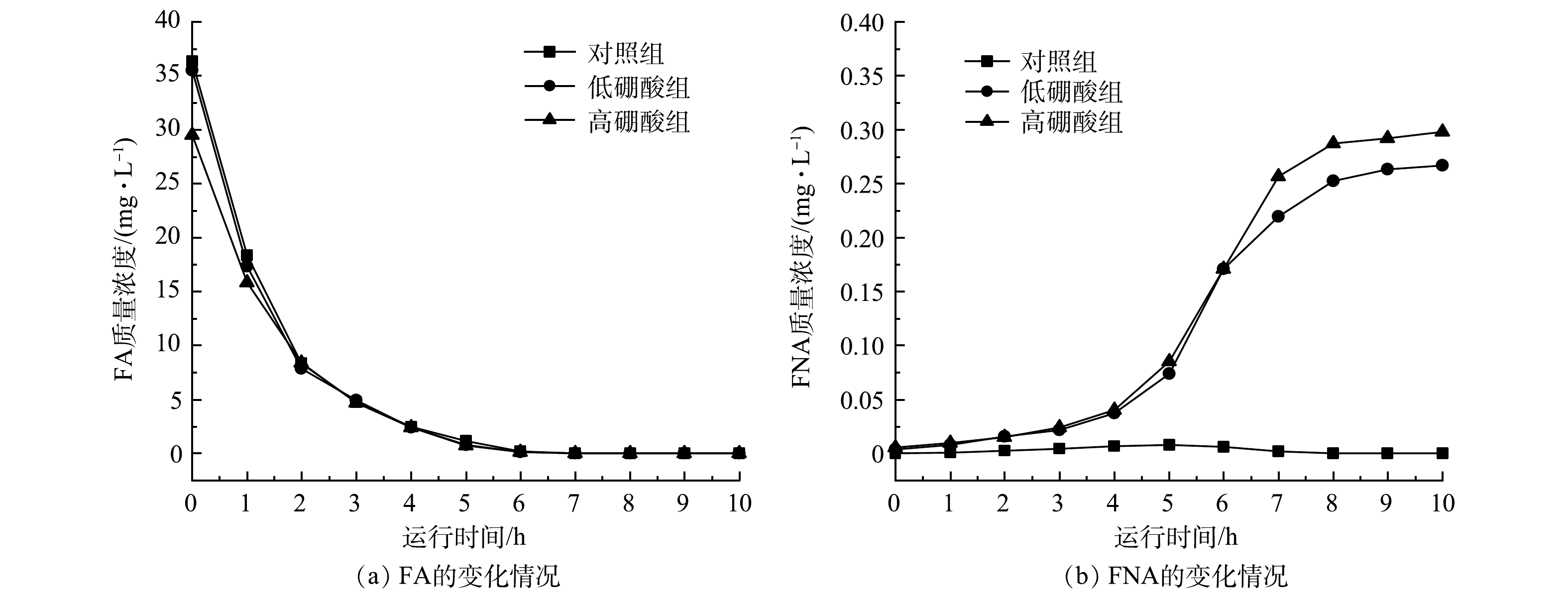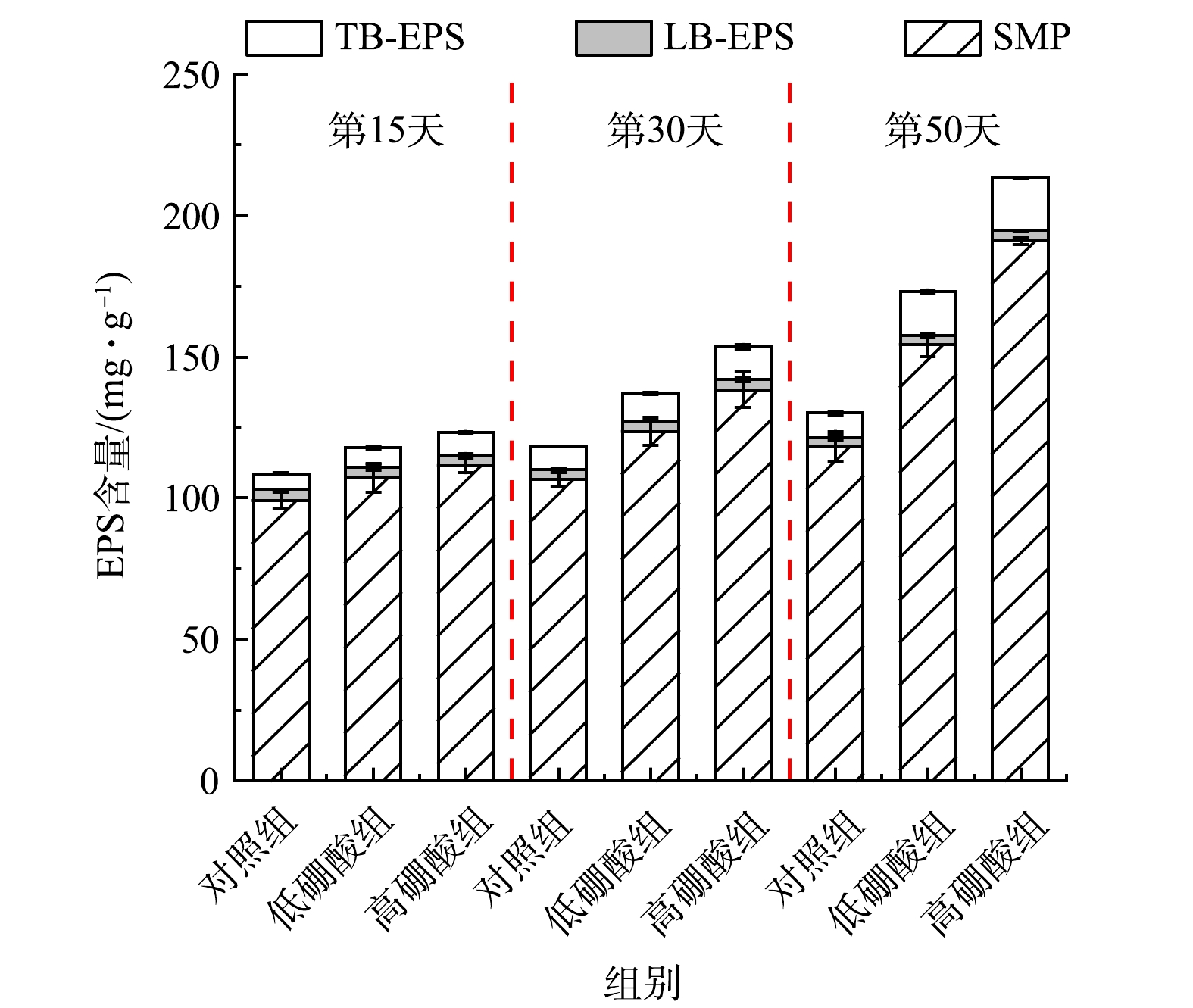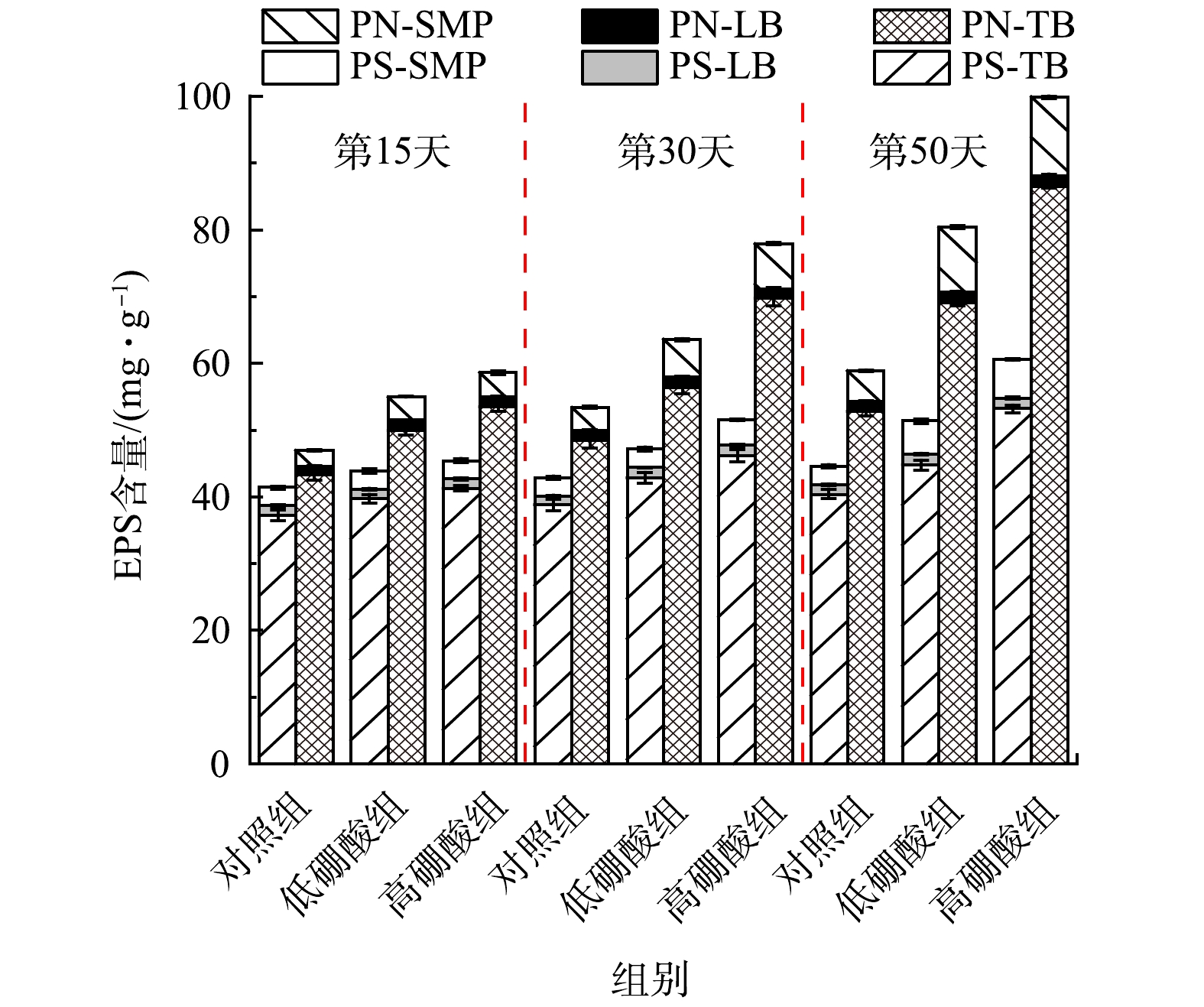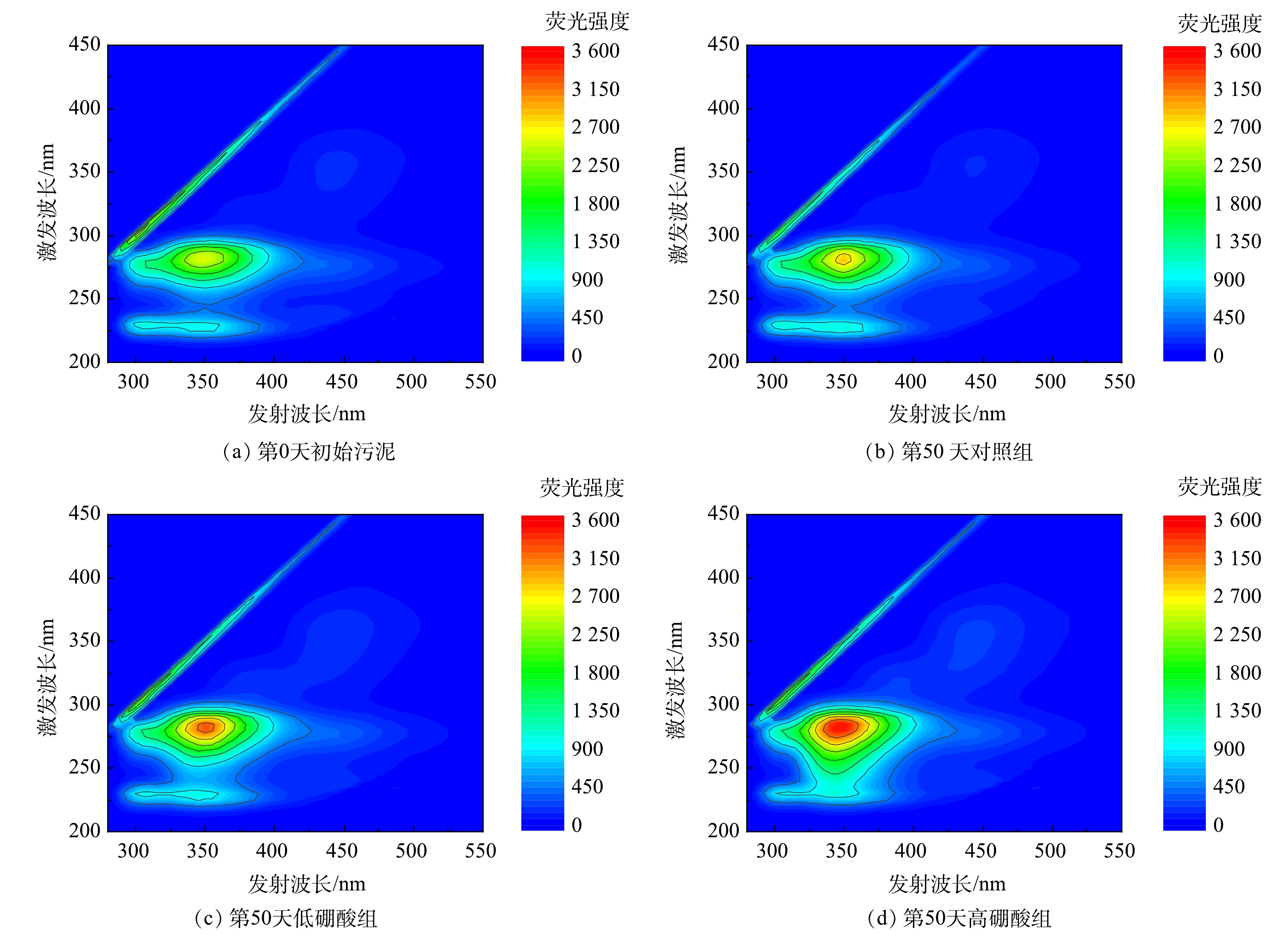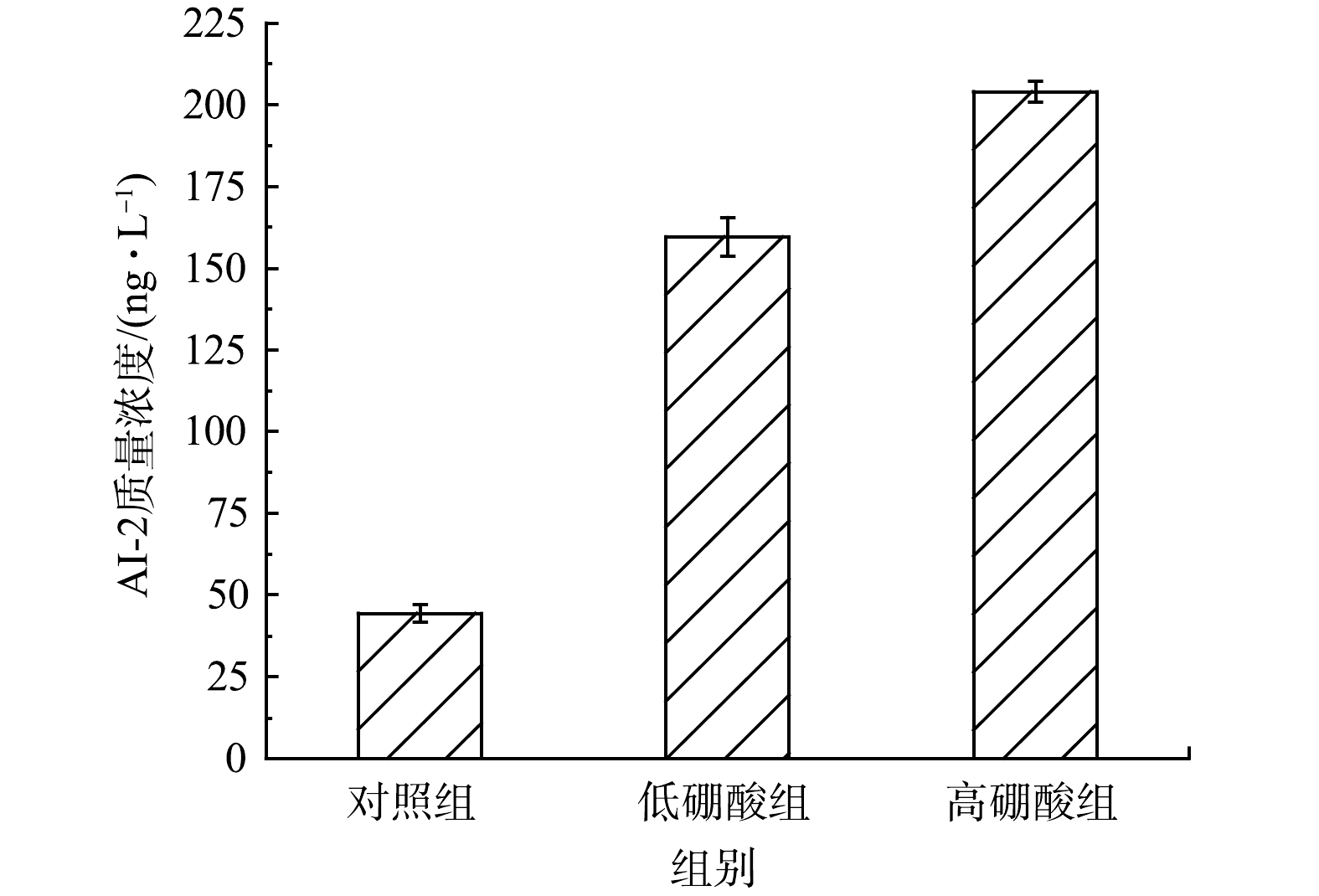-
短程硝化-厌氧氨氧化是一种高效的生物脱氮技术,具有无需外源添加碳源、污泥产量小、曝气能耗低、脱氮效率高的特点[1-2],而如何快速达到稳定的短程硝化效果是限制该技术推广的主要问题之一[3]。实现短程硝化的关键是抑制亚硝酸盐氧化细菌(nitrite-oxidizing bacteria,NOB)。为实现NOB的长期抑制,达到亚硝酸盐的稳定积累,往往需要多种控制手段的结合,包括低溶解氧(<2 mg·L−1)、高温(30~40 ℃)、高游离氨(free ammonia,FA) (1~10 mg·L−1)、高游离亚硝酸(free nitrous acid,FNA) (0.02~0.4 mg·L−1)等[4]。此外,优化反应器结构、外加磁场/超声波、添加化学试剂等方法均可强化短程硝化工艺[5]。目前高氨氮(
NH+4 -N为500~2 000 mg·L−1)废水可以实现较为稳定的短程硝化效果,而以城市废水为代表的低氨氮废水仍然较难实现短程硝化且稳定性不强。因此,寻找更为有效的短程硝化启动方法对处理城市废水至关重要。自诱导物-2(autoinducer-2,AI-2)是群体感应(quorum sensing,QS)信号分子的一种,负责细菌间的种间通讯,并通过调整相关基因的表达来促进胞外聚合物(extracellular polymeric substances,EPS)的产生,调节群落结构和菌群活性,进而影响细菌的生理功能。利用AI-2介导的QS系统被认为是废水处理中一种很有前途的调控方法。AI-2参与了生物膜的形成[6],降低AI-2的浓度可以有效控制膜生物污染[7-8]。作为AI-2的重要组成成分,硼的加入能够触发AI-2介导的QS,提高系统的处理效果。在颗粒污泥中加入硼,加速了颗粒污泥的生长,改善了SBR的沉降性能,增加了生物量,且颗粒污泥中AI-2的活性明显提高[9]。添加硼也能够实现厌氧氨氧化反应器的快速启动,并可显著促进厌氧氨氧化菌(anammox bacteria,An AOB)的富集,促进EPS分泌进而形成粒径更大、结构更紧密的An AOB颗粒污泥[10-11]。以上的研究结果表明,利用硼促进细菌AI-2介导的QS系统具有成为一种高效的调控策略的潜力。
为了快速获得稳定的短程硝化效果,实现稳定的亚硝酸盐积累,确保产生足够的底物用于厌氧氨氧化,本研究探究了硼对硝化细菌AI-2类QS系统的影响,考察了不同质量浓度的硼酸对亚硝酸盐富集的影响,并结合硝化细菌丰度的变化分析了影响机制,以期为短程硝化工艺的快速启动提供参考。
-
本研究污泥取自武汉沙湖污水处理厂的回流污泥,接种到序批式反应器(sequencing batch reactor, SBR)中,并逐步提高氮负荷来驯化富集自养硝化污泥。SBR的有效体积为18 L,水力停留时间16 h,每周期8 h(进水30 min,曝气6 h,沉淀30 min,出水30 min,静置30 min)。反应器在25 ℃下运行,运行期间保持溶解氧(dissolved oxygen,DO)>2 mg·L−1,pH在7~8。进水采用人工配水,氮源为(NH4)2SO4,用NaHCO3和Na2CO3做pH调节剂,还包括营养元素54 mg·L−1 KH2PO4、75 mg·L−1 KCl、147 mg·L−1 CaCl2·2H2O、49 mg·L−1 MgSO4·7H2O、和微量元素溶液 (采用SMOLDERS等[12]的配方)。
污泥培养40 d后,进水
NH+4 -N由初始的50 mg·L−1逐渐提高至200 mg·L−1,期间进水化学需氧量(chemical oxygen demand,COD)逐步降至0 mg·L−1。在这期间,反应器污泥的混合液悬浮固体浓度(mixed liquor suspended solids,MLSS)为3.5 g·L−1,污泥指数(sludge volume index,SVI)为81.9 mL·g−1,NH+4 -N降解率稳定在95%以上,出水NH+4 -N和NO−2 -N一直保持在5 mg·L−1以下,同时出水NO−3 -N逐渐积累,表明污泥中硝化细菌富集成功。 -
将SBR培养的硝化污泥接种至3个有效容积为1 L的小型反应器中(图1)。每天随进水向反应器中添加0.1 mmol·L−1硼酸(低硼酸组)和1 mmol·L−1硼酸(高硼酸组),并设置1组不添加硼(对照组)。反应器采用序批式运行,每循环为12 h (进水15 min、好氧10 h、沉淀30 min、出水15 min、静置1 h),采用人工进出水的方式,换水率50%,水力停留时间24 h。反应器初始MLSS为(2.13±0.05) g·L−1。运行期间保持DO>2 mg·L−1,pH在7~8,温度为25 ℃。
试验过程主要分为4个阶段:阶段Ⅰ(0~9 d),进水
NH+4 -N质量浓度为200 mg·L−1;阶段Ⅱ(10~19 d),进水NH+4 -N质量浓度为250 mg·L−1;阶段Ⅲ(20~29 d),进水NH+4 -N质量浓度为300 mg·L−1;阶段Ⅳ(30~50 d),进水NH+4 -N质量浓度为400 mg·L−1。定期监测反应器中DO、pH、
NH+4 -N、NO−2 -N、NO−3 -N、MLSS、混合液挥发性悬浮固体浓度(mixed liquid volatile suspended solids,MLVSS)、出水悬浮物(effluent suspend solid,ESS)等变化。 -
EPS的提取参照任杰辉等[13]的方法,并测定EPS中的总有机碳(total organic carbon,TOC)、蛋白质和多糖的含量。TOC的测定采用总有机碳分析仪(multi N/C 2 100,德国耶拿分析仪器股份公司)。多糖采用苯酚-浓硫酸法以葡萄糖为标准测定[14],并对此方法进行改进,在测定溶解性微生物产物(soluble microbial products,SMP)中的多糖含量前,先加入0.2 mL的氨基磺酸氨对样品中的
NO−2 -N进行掩蔽。蛋白质的测定采用二喹啉甲酸法(bicinchoninic acid assay,BCA)[15],选用SK3501 BCA 改良型试剂盒(上海生工,中国)。 -
三维荧光(fluorescence excitation-emission matrix,EEM)光谱的测定采用荧光分光光度计(F-7000 FL Spectrophotometer,HITACHI)[16]。以5 nm为增量激发波长从200 nm扫描到450 nm,发射波长从280 nm扫描至550 nm,扫描速度为2 000 nm·min−1,响应时间为0.002 s。为了消除拉曼散射和瑞利散射的影响,样品的荧光值均减去以纯水为空白的荧光值。
-
采用黄晓遇等[17]的柱前衍生-固相萃取-高效液相色谱荧光法测定反应器中的AI-2。
-
使用DNeasy PowerSoil Pro Kit (QIAGEN,德国)提取污泥DNA,用超微量分光光度计(KAIAO K5 800,北京)测定DNA质量浓度。针对细菌 16S rRNA、氨氧化细菌 16S rRNA 基因、硝酸盐氧化菌 16S rRNA进行实时荧光定量 PCR(real-time PCR)检测,所用引物与HU等[18]相同。
定量RCR反应采用PerfectStart Green qPCR SuperMix试剂盒(全式金,北京)。使用ABI QuantStudioTM 1 System (Thermo Fisher,美国)进行PCR扩增和检测。qPCR采用两步法:94 °C 30 s,然后94 °C 5 s,60 °C 30 s,40个循环。使用插入正确目的基因的质粒(pLB载体,天根,北京)作为标准,具体流程参考胡惠秩[15]的方法。所有qPCR运行结束时均进行熔融曲线分析,以确定扩增产物的特异性。
-
用标准方法测定污泥的MLSS、MLVSS和ESS[19]。
NH+4 -N采用纳氏试剂分光光度法,NO−3 -N采用麝香草酚分光光度法,NO−2 -N采用 N-( 1-萘基) 乙二胺分光光度法,TN的测定采用过硫酸钾氧化紫外分光光度法。pH和溶解氧的测定分别采用pH计(PB-10,赛多利斯)和溶解氧仪(HQ40d,哈希)。 -
亚硝酸盐积累率根据式(1)进行计算,游离氨(FA)和游离亚硝酸(FNA)根据式(2)和式(3)[20]进行计算。
式中:η为亚硝酸盐积累率;
CNO−2-N 为NO−2 -N质量浓度,mg·L−1;CNO−3-N 为NO−3 -N质量浓度,mg·L−1。式中:
CFA 为游离氨质量浓度,mg·L−1;CFNA 为游离亚硝酸质量浓度,mg·L−1;SNH+4-N 表示水中的ρ(NH+4 -N),mg·L−1;SNO−2-N 表示水中的ρ(NO−2 -N),mg·L−1;T为温度,℃。 -
每个实验重复3次进行统计学检验。采用SPSS软件(25.0版)进行方差分析(ANOVA),检验不同样本间的差异,P<0.05时认为差异显著。
-
由图2可知,反应器运行50 d后,在添加硼酸的条件下可以逐步实现短程硝化。当进水
NH+4 -N质量浓度由300 mg·L−1升高至400 mg·L−1时,添加硼酸的反应器运行效果发生显著变化。低硼酸组出水中NO−2 -N急速上升并维持在320 mg·L−1以上,NO−3 -N维持在15 mg·L−1以下,亚硝酸盐积累率达到95%以上;高硼酸组NOB活性被抑制的更强烈,出水NO−2 -N维持在340 mg·L−1以上,出水NO−3 -N维持在10 mg·L−1以下,亚硝酸盐积累率达到98%以上。这表明添加硼酸时AOB活性保持稳定,而NOB活性在长期运行后几乎完全被抑制,从而得到较高质量浓度的NO−2 -N,快速达到短程硝化的效果。FA和FNA质量浓度与
NH+4 -N和NO−2 -N质量浓度以及反应器中废水的pH密切相关(FA和FNA分别用式(2)和(3)计算)。反应器稳定运行后,在第45天时对1个循环周期内好氧阶段的FA和FNA每小时的变化进行监测,结果如图3所示。在初期,FA高达36.33 mg·L−1;但随着NH+4 -N的去除和pH的下降,4 h后FA迅速下降至一个较低的值。相反,由于较低的pH和较高的NO−2 -N质量浓度,低硼酸组和高硼酸组的FNA在反应器运行周期结束时分别增加至0.27 mg·L−1和0.30 mg·L−1。有研究表明,FA对NOB的抑制质量浓度为0.1~1.0 mg·L−1,对AOB的抑制质量浓度为10~150 mg·L−1[21];FNA对AOB和NOB的抑制质量浓度分别为0.4 mg·L−1和0.02 mg·L−1[22]。由此可知,实验组的NOB处于FA和FNA的交替抑制中,而AOB没有受到FA和FNA的抑制。 -
硼酸的投加显著促进了污泥生物量的积累(表1)。低硼酸组和高硼酸组的平均生长速率较对照组分别增加了0.018 g·(L·d)−1和0.030 g·(L·d)−1(以MLSS计)。在之前的研究中,ZHANG等[9]发现,添加硼酸使得SBR中的好氧颗粒污泥具有更大的生物量。类似地,吴桂荣[10]发现,加硼反应器的颗粒污泥体积平均粒径(430.469 μm)略大于不加硼反应器颗粒污泥的体积平均粒径(357.122 μm)。本实验结果也验证了硼酸加速污泥平均生长速率的结论。
-
EPS是一种细菌代谢产物,在细菌的粘附聚集、信息交流方面发挥重要作用[23]。根据结合的紧密程度,EPS又可以划分为SMP、松散结合EPS(loosely bound EPS,LB-EPS)和紧密结合EPS (tightly bound EPS,TB-EPS)[24]。EPS中有机组分主要包括蛋白质、多糖、腐殖质样物质、醛酸、核酸和脂类[25],约占其总量的80%~90%。EPS的总含量通常可以用TOC来表征[26]。如图4所示,总EPS随着时间的推移逐渐增加,且实验组EPS含量显著高于对照组。硼的加入促进了硝化细菌中EPS的分泌,并对EPS的组分产生影响。反应器运行50 d后,低硼酸组和高硼酸组的总EPS含量较对照组分别提高了30.46%和61.61%。微生物分泌的EPS通常被认为能影响污水处理系统中微生物的聚集特性和结构功能,特别是生物膜的形成、颗粒污泥造粒等[25]。此外,硝化污泥中TB-EPS的含量显著高于SMP和LB-EPS的含量,这表明TB 是EPS的主要成分。其中硼酸对TB-EPS的促进最为明显(对照组106.49 mg·g −1,低硼酸组135.66 mg·g −1,高硼酸组169.11 mg·g−1)。在吴桂荣[10]的研究中,加硼反应器总EPS的含量也显著高于不加硼反应器,其中TB-EPS由102.67 mg·g−1增加至147.69 mg·g−1。这表明外源添加硼酸有助于胞外聚合物的分泌。
蛋白质(protein,PN)和多糖(polysaccharide,PS)是EPS的重要组成部分。PN的氨基酸组成和二级结构有助于疏水相互作用,进而提高微生物聚集体的活性[27]。PS具有很大的分子量和具有活性侧链的长碳主链结构,这是EPS有高絮凝特点的原因[28]。低硼酸组和高硼酸组PS的含量较对照组分别增加了15%和36%,PN的含量增加了37%和70%(图5)。这表明添加硼酸对PN和PS都有促进作用,但对PN的促进更明显,这与吴桂荣[10]的研究结果相似。PN是EPS的疏水部分,高含量的PN有利于微生物的附着和活性污泥的稳定[29]。本研究中,添加硼酸后TB-EPS中PN/PS值也显著增加,对照组为1.31,低硼酸组为1.54,高硼酸组为1.63。EPS的改变与活性污泥EES的变化一致,说明添加硼酸的活性污泥的稳定性和沉降性增强。
多糖可以增加EPS的持水量,而蛋白质具有疏水的结构,所以蛋白质/多糖的比例会影响污泥的沉降性能[30]。反应器运行过程中蛋白质含量始终高于多糖,PN/PS的值的变化如表2所示。随着时间的推移,LB的PS/PN值变化不显著,SMP和TB的PN/PS值逐渐上升,其中TB的PS/PN值变化尤为显著。在反应器运行第15、30、50天时,低硼酸组中TB的PN/PS值分别为1.26、1.32、1.54;高硼酸组中TB的PN/PS值分别为为1.30、1.49、1.63;而对照组中TB的PN/PS值分别为仅为1.16、1.25、1.31。添加硼酸后,活性污泥的沉降性能变好和生物量增加也可能与硝化污泥的EPS组成成分的变化有关。
EEM图谱可表征EPS组分的变化,结果如图6所示,EEM图谱中主要有4个荧光峰A、B、C和D,分别位于355 nm/445 nm、280 nm/345 nm、230 nm/310 nm、230 nm/345 nm。根据COBLE等[31]的方法,确定A峰为类腐殖质峰,A峰荧光强度较弱;B峰和D峰为类蛋白质峰,其中荧光与芳香族氨基酸色氨酸相关;C峰为类蛋白质峰,其中荧光与芳香族氨基酸酪氨酸相关。光谱的所有荧光参数,包括峰位置、荧光强度列于表3中。由EEM图谱可知,A、B、C和D峰的荧光强度均随着时间的推移逐渐升高,添加硼酸的反应器荧光强度增加尤为显著。其中B峰增加的幅度最大,低硼酸组和高硼酸组的色氨酸峰B强度分别较对照组增加了16%和23%。可见,硼酸对EPS中的荧光物质影响显著,尤其是以色氨酸为代表的疏水性氨基酸。色氨酸是一种疏水氨基酸,疏水性有助于微生物的聚集和活性污泥的稳定,这也解释了活性污泥稳定性增强的原因[32]。类似的结果是,在ZHANG等[9]的研究中,添加硼酸的反应器好氧颗粒污泥EPS的色氨酸峰强度增加了60%。因此,外源添加硼酸能改变EPS的组成成分,促进微生物分泌更多的胞外蛋白,增加色氨酸类氨基酸的形成,从而增强污泥的稳定性。
-
由于添加硼酸显著提高了
NO−2 -N的积累速率,因此,我们采用实时荧光定量PCR技术分析了硼酸对硝化细菌活性的影响。硝化细菌与细菌总数绝对丰度的比值为硝化细菌的相对丰度。由表4可知,添加硼酸能使NOB的丰度增加。与对照组相比,低硼酸组和高硼酸组AOB和Nitrobacter的相对丰度没有显著变化;但Nitrospira的相对丰度分别提高了5.33%和9.11%(P<0.01),说明AI-2对硝化细菌的影响主要针对Nitrospira。这与通过其他方式成功启动的短程硝化反应器有明显不同[33],通过超声波处理增强AOB活性并抑制了NOB活性,进而启动短程硝化工艺,其中NOB中的Nitrospira菌群在30 d内消失。 -
AI-2介导的QS与水处理过程中细菌的结构和功能有着密切的联系[34-35]。运行50 d后出水中实验组AI-2的质量浓度显著高于对照组(图7)。添加硼酸会触发AI-2介导的群体感应,低硼酸组和高硼酸组的AI-2质量浓度分别是对照组的3倍和4倍,这可能是由于硼与DPD以及LuxP-AI-2共复合物的形成受到刺激[9]。AI-2有利于EPS总量和细胞粘附性的增加[35]。对AI-2质量浓度和污泥的平均生长速率、总EPS、TB-EPS的PN/PS值、Nitrospira菌群相对丰度之间进行皮尔逊相关性分析发现,AI-2质量浓度与TB-EPS的PN/PS值之间显著相关(P=0.02),与其他变量之间总体趋势一致但相关性不显著(P>0.09),说明AI-2主要通过调控TB-EPS进而影响总EPS、污泥的平均生长速率和功能细菌相对丰度的变化。综上所述,硼酸对硝化污泥影响的可能机制如下:添加硼酸促进细菌分泌AI-2;AI-2的调控虽然增加了NOB数量,但降低了NOB活性,刺激EPS产生,改变微生物群落结构,进而促进短程硝化反应器的启动。
短程硝化系统的性能在很大程度上取决于硝化细菌的活性和生长速度,而另一种信号分子N-酰基高丝氨酸内酯(N-acyl homoserine lactones,AHLs)在介导QS过程中也发挥了重要作用[36]。不同类型的AHL对硝化系统的作用不同,C4-HSL与AOB活性有关,有利于亚硝酸盐的积累;而C6-HSL和C8-HSL能够抑制AOB活性,促进NOB活性[37-38]。添加适当类型的AHL可以选择性地促进AOB的活性和生长,从而为AOB提供优于NOB的竞争优势,有助于实现稳定的亚硝酸盐积累[37]。在本研究中,虽然反应器维持了良好的短程硝化效果,但AOB的丰度没有显著增加,可能是由于经硼酸处理后AOB活性增加,而AI-2虽然能提高NOB中Nitrospira菌群相对丰度,但可能种间通讯强化了FA和FNA对亚硝酸盐还原酶的抑制作用,NOB活性仍然保持在较低水平,进而导致NO2−-N的积累。
-
1)硼酸的加入能够促进反应器内NO2−-N的积累,从而快速实现短程硝化。
2)硼酸的加入能够显著增加信号分子AI-2的含量,进而增加了EPS的产量,尤其对EPS中PN的促进更为明显;以色氨酸为代表的疏水性氨基酸的含量增加显著。
3)从QS调控的角度分析,高浓度的AI-2强化了微生物的种间通讯,抑制了NOB的活性、加速了EPS的形成,改变了微生物群落结构,从而成功启动了短程硝化反应器。
硼对短程硝化工艺快速启动的影响
Effect of Boron on rapid start-up of shortcut nitrification process
-
摘要: 针对当前低氨氮废水较难实现短程硝化的问题,通过向3个反应器中添加不同质量浓度的硼酸(自诱导物-2(autoinducer-2,AI-2)的活化因子),研究其对自养硝化污泥系统群体感应(quorum sensing,QS)的影响,以实现短程硝化系统的快速启动。结果表明,当进水
NH+4 -N质量浓度为400 mg·L−1时,低硼酸组和高硼酸组都快速实现了稳定的短程硝化效果,但对照组的硝化效果仍无明显变化。与此同时,低硼酸组和高硼酸组的胞外聚合物(extracellular polymeric substances,EPS)含量较对照组分别增加了30.46%和61.61%,EPS中蛋白质所占比重增加,以色氨酸为代表的疏水性氨基酸增加。此外,低硼酸组和高硼酸组的AI-2质量浓度分别是对照组的3倍和4倍。以上研究结果说明硼酸可促进AI-2介导的QS,从而帮助系统快速实现短程硝化。Abstract: Aiming at the current problem that it is difficult to achieve short-cut nitrification of low ammonia nitrogen wastewater, the effects of different concentrations of boric acid (the activation factor of autoinducer-2 (AI-2)) adding into three reactors on quorum sensing (QS) of autotrophic nitrification sludge system were studied to realize the quick start-up of the shortcut nitrification system. The results showed that when the concentration ofNH+4 -N was 400 mg·L−1, both the low and high boric acid groups quickly achieved stable short-cut nitrification, but no significant change occurred in the nitrification effect of the control group. At the same time, compared with the control group, the content of extracellular polymeric substances (EPS) in the low and high boric acid groups increased by 30.46% and 61.61%, respectively. The proportion of protein in EPS increased, and the hydrophobic amino acids represented by tryptophan increased. In addition, AI-2 concentrations in the low-boric acid and high-boric acid groups were three and four times as high as that in the control group, respectively. In summary, boric acid can promote AI-2 mediated QS, thus help the system quickly realize short-cut nitrification.-
Key words:
- Boron /
- quorum sensing /
- shortcut nitrification /
- AI-2
-
表 1 50 d后3组反应器中自养硝化污泥的特性
Table 1. Characteristics of autotrophic nitrification sludge in three groups of reactors after 50 d
组别 初始MLSS/(g·L−1) 实验末期MLSS/(g·L−1) 实验末期MLVSS/(g·L−1) 实验末期VSS/SS 平均ESS/(g·(L·d)−1) 平均生长速率/(g·(L·d)−1) 对照组 2.13 ± 0.05 3.11 ± 0.03 1.86 ± 0.08 0.597 0.15 0.130 低硼酸组 2.13 ± 0.05 3.57 ± 0.07 2.33 ± 0.01 0.652 0.12 0.148 高硼酸组 2.13 ± 0.05 3.62 ± 0.06 2.39 ± 0.04 0.661 0.13 0.160 表 2 3个A/O反应器PN/PS值
Table 2. PN/PS values of EPS in the three groups of reactors
组别 SMP LB TB 15 d 30 d 50 d 15 d 30 d 50 d 15 d 30 d 50 d 对照组 0.91 1.27 1.64 0.92 1.00 1.04 1.16 1.25 1.31 低硼酸组 1.31 2.04 1.97 1.02 0.99 0.94 1.26 1.32 1.54 高硼酸组 1.35 1.77 2.03 1.02 0.95 0.93 1.30 1.49 1.63 表 3 不同时期3组反应器EPS的EEM图谱峰位置和峰强度
Table 3. Peak positions and intensities of EEM spectra of EPS in three groups of reactor during different periods
组别 A峰 B峰 C峰 D峰 (Ex/Em)/nm 峰强度 (Ex/Em)/nm 峰强度 (Ex/Em)/nm 峰强度 (Ex/Em)/nm 峰强度 初始污泥 355/445 163.495 280/345 2 564.341 230/310 787.594 230/345 698.425 50 d后对照组 355/445 199.238 280/345 2 857.216 230/310 819.167 230/345 897.456 50 d后低硼酸组 355/445 216.951 280/345 3 312.845 230/310 871.534 230/345 917.816 50 d后高硼酸组 355/445 221.338 280/345 3525.259 230/310 983.037 230/345 1065.931 表 4 3组反应器AOB和NOB的相对丰度
Table 4. Relative abundance of AOB and NOB in the three groups of reactors
处理组 AOB的相对丰度/% Nitrobacter的相对丰度/% Nitrospira的相对丰度/% 对照组 18.92 0.23 11.26 低硼酸组 18.68 0.24 16.59* 高硼酸组 19.22 0.29 20.37* 注:*表示差异显著,P<0.05。 -
[1] 袁林杰, 袁林江, 陈希, 等. 厌氧氨氧化UASB系统对氨态氮的超量去除机制研究[J]. 中国环境科学, 2021, 41(10): 4686-4694. doi: 10.3969/j.issn.1000-6923.2021.01.001 [2] 左富民, 郑蕊, 隋倩雯, 等. 一体式短程硝化-厌氧氨氧化工艺启动过程的亚硝酸盐调控[J]. 环境科学, 2021, 42(11): 5472-5480. [3] DENG S Y, PENG Y Z, ZHANG L, et al. Advanced nitrogen removal from municipal wastewater via two-stage partial nitrification-simultaneous anammox and denitrification (PN-SAD) process[J]. Bioresource Technology, 2020, 304: 122955. doi: 10.1016/j.biortech.2020.122955 [4] 樊宇菲, 谢弘超, 周慧, 等. 高氨氮废水半短程硝化控制及曝气经济性运行优化[J]. 环境科学学报, 2021, 41(4): 1275-1282. [5] 汪涛, 袁路子, 罗正, 等. 短程硝化工艺强化方法研究进展[J]. 工业水处理, 2020, 40(7): 1-5. [6] XU H, LIU Y. Control of microbial attachment by inhibition of ATP and ATP-mediated autoinducer-2[J]. Biotechnology and Bioengineering, 2010, 107(1): 31-36. doi: 10.1002/bit.22796 [7] ZHANG X, LEE K, YU H, et al. Photolytic quorum quenching: A new anti-biofouling strategy for membrane bioreactors[J]. Chemical Engineering Journal, 2019, 378: 122235. doi: 10.1016/j.cej.2019.122235 [8] LEE K, KIM Y W, LEE S, et al. Stopping autoinducer-2 chatter by means of an indigenous bacterium (Acinetobacter sp DKY-1): A new antibiofouling strategy in a membrane bioreactor for wastewater treatment[J]. Environmental Science & Technology, 2018, 52(11): 6237-6245. [9] ZHANG S H, YU X, GUO F, et al. Effect of interspecies quorum sensing on the formation of aerobic granular sludge[J]. Water Science and Technology, 2011, 64(6): 1284-1290. doi: 10.2166/wst.2011.723 [10] 吴桂荣. AI-2活化因子(硼)对厌氧氨氧化反应器污泥颗粒化及菌群结构的影响[D]. 广州: 广州大学, 2018. [11] 苏一魁, 吴桂荣, 荣宏伟, 等. 硼对厌氧氨氧化反应器启动过程及菌群结构的影响[J]. 中国给水排水, 2019, 35(13): 6-10. [12] SMOLDERS G J, VAN DER MEIJ J, VAN LOOSDRECHT M C, et al. Stoichiometric model of the aerobic metabolism of the biological phosphorus removal process[J]. Biotechnology and Bioengineering, 1994, 44(7): 837-848. doi: 10.1002/bit.260440709 [13] 任杰辉, 程文, 万甜, 等. 缓冲液盐度对热提取活性污泥胞外聚合物的影响[J]. 环境科学学报, 2018, 38(8): 3054-3060. [14] GERHARDT P. Methods for General and Molecular Bacteriology[M]. Washington, D. C. : American Society for Microbiology, 1994. [15] 胡惠秩. 常/低温下AHLs类群体感应信号分子对SBBR系统影响的研究[D]. 哈尔滨: 哈尔滨工业大学, 2017. [16] ZHU L, QI H Y, LV M L, et al. Component analysis of extracellular polymeric substances (EPS) during aerobic sludge granulation using FTIR and 3D-EEM technologies[J]. Bioresource Technology, 2012, 124: 455-459. doi: 10.1016/j.biortech.2012.08.059 [17] 黄晓遇, 谭炳琰, 李淳峰, 等. 柱前衍生-固相萃取-高效液相色谱荧光测定生物脱氮反应器中痕量信号分子AI-2[J]. 环境工程学报, 2019, 13(1): 109-115. doi: 10.12030/j.cjee.201808042 [18] HU H, HE J, LIU J, et al. Biofilm activity and sludge characteristics affected by exogenous N-acyl homoserine lactones in biofilm reactors[J]. Bioresource Technology, 2016, 211: 339-347. doi: 10.1016/j.biortech.2016.03.068 [19] 国家环境保护总局. 水和废水监测分析方法[M]. 4版. 北京: 中国环境科学出版社, 2002. [20] HE S, ZHANG Y, NIU Q, et al. Operation stability and recovery performance in an anammox EGSB reactor after pH shock[J]. Ecological Engineering, 2016, 90: 50-56. doi: 10.1016/j.ecoleng.2016.01.084 [21] ANTHONISEN A C, LOEHR R C, PRAKASAM T B, et al. Inhibition of nitrification by ammonia and nitrous acid[J]. Journal Water Pollution Control Federation, 1976, 48(5): 835-852. [22] VADIVELU V M, YUAN Z, FUX C, et al. The inhibitory effects of free nitrous acid on the energy generation and growth processes of an enriched nitrobacter culture[J]. Environmental Science & Technology, 2006, 40(14): 4442-4448. [23] CHEN H, LI A, CUI D, et al. N-Acyl-homoserine lactones and autoinducer-2-mediated quorum sensing during wastewater treatment[J]. Applied Microbiology and Biotechnology, 2018, 102(3): 1119-1130. doi: 10.1007/s00253-017-8697-3 [24] JIA F X, YANG Q, LIU X H, et al. Stratification of extracellular polymeric substances (EPS) for aggregated anammox microorganisms[J]. Environmental Science & Technology, 2017, 51(6): 3260-3268. [25] SHI Y, HUANG J, ZENG G, et al. Exploiting extracellular polymeric substances (EPS) controlling strategies for performance enhancement of biological wastewater treatments: An overview[J]. Chemosphere, 2017, 180: 396-411. doi: 10.1016/j.chemosphere.2017.04.042 [26] SU X Y, ZHANG Z G. Structural characteristics of extracellular polymeric substances (EPS) in membrane bioreactor and their adsorptive fouling[J]. Water Science and Technology, 2018, 77(6): 1537-1546. doi: 10.2166/wst.2018.033 [27] HOU X, LIU S, ZHANG Z. Role of extracellular polymeric substance in determining the high aggregation ability of anammox sludge[J]. Water Research, 2015, 75: 51-62. doi: 10.1016/j.watres.2015.02.031 [28] YUAN S J, SUN M, SHENG G P, et al. Identification of key constituents and structure of the extracellular polymeric substances excreted by Bacillus megaterium TF10 for their flocculation capacity[J]. Environmental Science & Technology, 2011, 45(3): 1152-1157. [29] LV J, WANG Y, ZHONG C, et al. The effect of quorum sensing and extracellular proteins on the microbial attachment of aerobic granular activated sludge[J]. Bioresource Technology, 2014, 152: 53-58. doi: 10.1016/j.biortech.2013.10.097 [30] ZHANG F, YANG H, GUO D, et al. Effects of biomass pyrolysis derived wood vinegar (WVG) on extracellular polymeric substances and performances of activated sludge[J]. Bioresource Technology, 2019, 274: 25-32. doi: 10.1016/j.biortech.2018.11.064 [31] COBLE P G. Characterization of marine and terrestrial DOM in seawater using excitation-emission matrix spectroscopy[J]. Marine Chemistry, 1996, 51(4): 325-346. doi: 10.1016/0304-4203(95)00062-3 [32] LIU Y Q, LIU Y, TAY J H. The effects of extracellular polymeric substances on the formation and stability of biogranules[J]. Applied Microbiology and Biotechnology, 2004, 65(2): 143-148. [33] ZHENG M, LIU Y C, XIN J, et al. Ultrasonic treatment enhanced ammonia-oxidizing bacterial (AOB) activity for nitritation process[J]. Environmental Science & Technology, 2016, 50(2): 864-871. [34] XU H, LIU Y. Reduced microbial attachment by D-amino acid-inhibited AI-2 and EPS production[J]. Water Research, 2011, 45(17): 5796-5804. doi: 10.1016/j.watres.2011.08.061 [35] SUN S P, LIU X, MA B Y, et al. The role of autoinducer-2 in aerobic granulation using alternating feed loadings strategy[J]. Bioresource Technology, 2016, 201: 58-64. doi: 10.1016/j.biortech.2015.11.032 [36] ZHAO Z C, XIE G J, LIU B F, et al. A review of quorum sensing improving partial nitritation-anammox process: Functions, mechanisms and prospects[J]. Science of the Total Environment, 2021, 765: 142703. doi: 10.1016/j.scitotenv.2020.142703 [37] SUN Y, GUAN Y, WANG D, et al. Potential roles of acyl homoserine lactone based quorum sensing in sequencing batch nitrifying biofilm reactors with or without the addition of organic carbon[J]. Bioresource Technology, 2018, 259: 136-145. doi: 10.1016/j.biortech.2018.03.025 [38] FENG Z, SUN Y, LI T, et al. Operational pattern affects nitritation, microbial community and quorum sensing in nitrifying wastewater treatment systems[J]. Science of the Total Environment, 2019, 677: 456-465. doi: 10.1016/j.scitotenv.2019.04.371 -








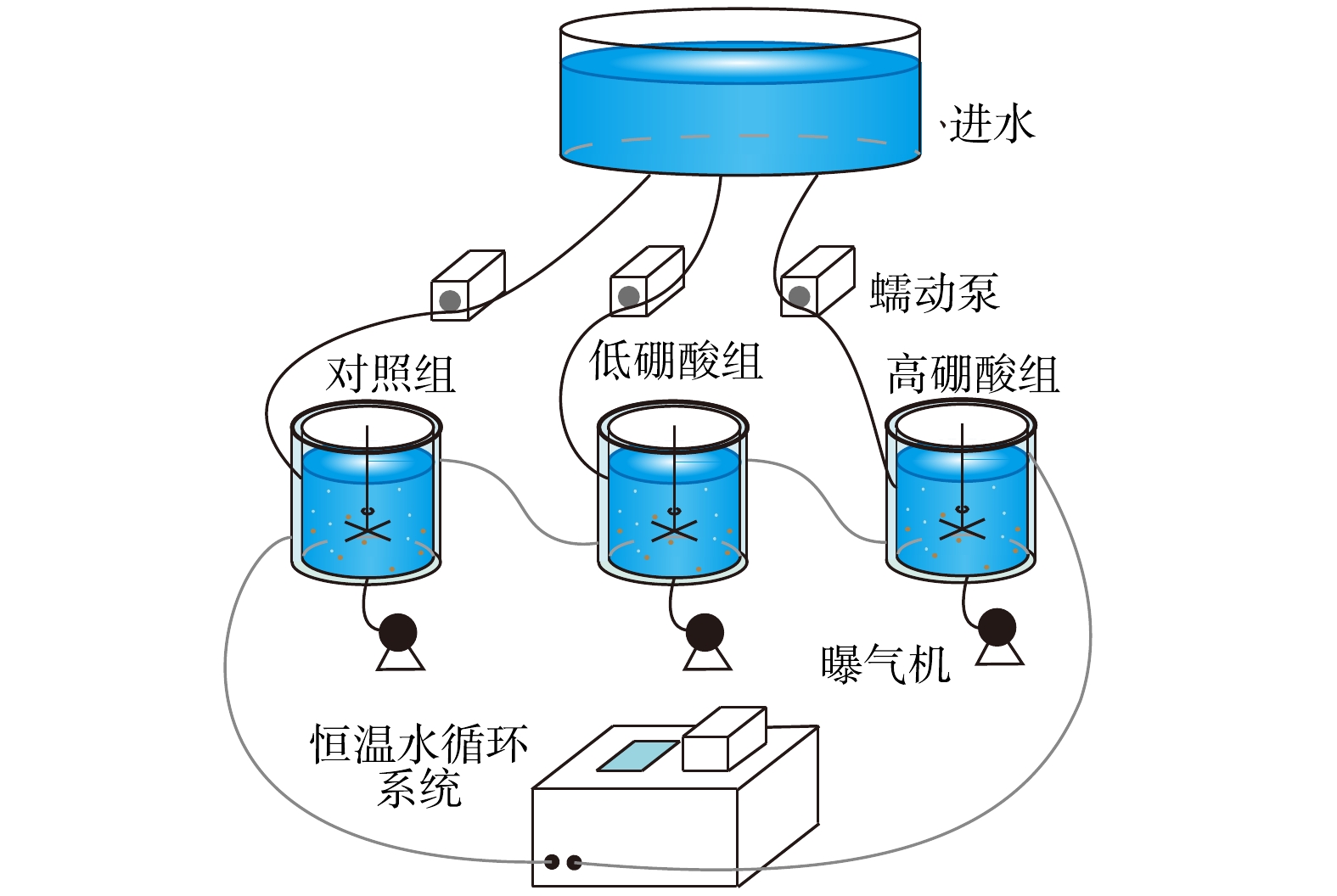
 下载:
下载:

